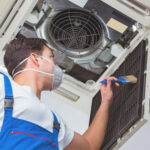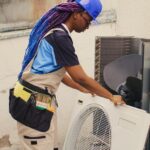
How to Improve Indoor Air Quality
Indoor air quality is a topic often overlooked but crucial for maintaining a healthy home environment. With the average person spending approximately 90% of their time indoors, the quality of the air we breathe within our homes can significantly impact our health and well-being. In Sterling, VA, where weather extremes can keep residents indoors for extended periods, ensuring optimal indoor air quality becomes paramount. In this blog post, we’ll explore practical tips and strategies to improve indoor air quality and create a healthier living space for you and your family.
Understanding the Importance of Indoor Air Quality
Indoor air quality refers to the purity of the air within buildings, including homes, offices, and other enclosed spaces. It encompasses various factors such as the presence of pollutants, humidity levels, and ventilation. High-quality indoor air is essential for promoting good health and well-being, as we spend the majority of our time indoors.
Poor indoor air quality can lead to a range of health issues, including respiratory problems, allergies, and even more severe conditions like asthma and cardiovascular diseases. Therefore, understanding and actively improving indoor air quality is crucial for creating a healthy living environment.
The Impact of Poor Indoor Air Quality on Health
Poor indoor air quality can have significant adverse effects on our health, impacting both physical and mental well-being. Exposure to indoor air pollutants such as dust, mold, pet dander, and volatile organic compounds (VOCs) can trigger allergic reactions and exacerbate respiratory conditions like asthma and bronchitis.
Long-term exposure to indoor air pollutants has been linked to an increased risk of developing chronic health conditions such as lung cancer, heart disease, and neurological disorders. Additionally, poor indoor air quality can affect cognitive function and mood, leading to fatigue, irritability, and decreased productivity.
Unique Challenges of Maintaining Air Quality in Sterling, VA
Sterling, VA, presents unique challenges when it comes to maintaining indoor air quality due to its climate and environmental factors. The region experiences hot and humid summers, which can promote the growth of mold and mildew indoors if proper ventilation and humidity control measures are not in place.
Additionally, during colder months, residents rely heavily on heating systems, which can introduce indoor air pollutants such as carbon monoxide if not adequately maintained. Furthermore, the proximity to urban areas may increase the infiltration of outdoor pollutants into indoor spaces, necessitating diligent air quality management strategies for residents.
Common Indoor Air Pollutants Found in Homes
Indoor air quality is a critical aspect of maintaining a healthy home environment. However, many homes unknowingly harbor various pollutants that can compromise the air we breathe. Identifying these common indoor air pollutants is the first step toward improving indoor air quality. Here are five of the most prevalent indoor air pollutants found in homes:
- Dust and Dust Mites: Dust particles and dust mites are common indoor allergens that can trigger respiratory issues and allergic reactions in sensitive individuals.
- Pet Dander: Shed skin cells from pets, known as pet dander, can become airborne and contribute to indoor air pollution, particularly in households with pets.
- Mold Spores: Mold growth in damp or poorly ventilated areas of the home can release spores into the air, leading to respiratory problems and exacerbating allergies and asthma.
- Volatile Organic Compounds (VOCs): VOCs are emitted by household products such as paints, cleaning supplies, and furniture, and can contribute to indoor air pollution, causing headaches, nausea, and respiratory irritation.
- Tobacco Smoke: Secondhand smoke from cigarettes contains numerous harmful chemicals and particles that can linger in indoor air, posing health risks to nonsmokers, especially children and individuals with respiratory conditions.
Sources of Indoor Air Pollution and Contaminants
Indoor air pollution can originate from various sources both inside and outside the home. Inside the home, common sources include combustion appliances such as stoves, fireplaces, and gas heaters, which can produce carbon monoxide and other harmful gasses if not properly ventilated.
Household activities like cooking, cleaning, and smoking also contribute to indoor air pollution. Outside pollutants such as vehicle emissions, industrial emissions, and pollen can infiltrate indoor spaces through windows, doors, and ventilation systems. Identifying and mitigating these sources is crucial for improving indoor air quality.
Assessing Your Home’s Indoor Air Quality: Where to Start
Assessing indoor air quality is the first step towards creating a healthier home environment. Start by conducting a thorough inspection of your home, looking for signs of moisture, mold, and musty odors, which indicate potential air quality issues. Use indoor air quality monitors to measure levels of common pollutants like particulate matter, VOCs, and radon.
Additionally, consider hiring a professional indoor air quality inspector to conduct a comprehensive assessment of your home’s air quality. Identifying specific pollutants and their sources will help you develop an effective plan for improving indoor air quality.
Practical Tips for Improving Indoor Air Quality
Improving indoor air quality involves adopting various practical strategies to reduce exposure to pollutants and enhance ventilation. Start by regularly cleaning and dusting your home to remove accumulated dust, pet dander, and other allergens. Use natural cleaning products or those labeled as low-VOC to minimize indoor air pollution from cleaning chemicals.
Ensure proper ventilation in your home by opening windows and using exhaust fans in kitchens and bathrooms. Consider investing in air purifiers and HVAC filters to remove airborne pollutants and allergens. These simple yet effective tips can significantly improve indoor air quality and promote a healthier living environment.
HVAC Systems: Key Players in Air Quality Management
HVAC (heating, ventilation, and air conditioning) systems play a crucial role in maintaining indoor air quality. Properly designed and maintained HVAC systems help regulate temperature, humidity, and air circulation, reducing the concentration of indoor air pollutants. Regular maintenance, including cleaning ducts and replacing filters, is essential to ensure HVAC systems operate efficiently and effectively remove contaminants from indoor air.
Additionally, advanced HVAC systems may incorporate features such as air purification technologies and energy recovery ventilation to further enhance indoor air quality. Understanding the importance of HVAC systems in air quality management is essential for creating a healthy indoor environment.
The Role of Ventilation in Enhancing Indoor Air Quality
Ventilation is a critical factor in enhancing indoor air quality by diluting indoor air pollutants and bringing in fresh outdoor air. Proper ventilation helps remove stale air and moisture from indoor spaces, reducing the risk of mold growth and improving overall air circulation. Natural ventilation, such as opening windows and doors, can be effective in mild weather conditions.
However, mechanical ventilation systems, including exhaust fans and balanced ventilation systems, are often necessary to ensure consistent airflow and pollutant removal. Understanding the role of ventilation systems in indoor air quality management is essential for creating a comfortable and healthy indoor environment.
Choosing Air Purifiers: What You Need to Know
When selecting an air purifier for your home, consider factors such as the size of the area you want to purify, the type of pollutants you want to target, and the filtration technology used by the purifier. HEPA filters are highly effective at removing airborne particles, while activated carbon filters can help eliminate odors and gasses.
Look for air purifiers with a high clean air delivery rate (CADR) and energy-efficient operation. Additionally, consider features like noise levels, maintenance requirements, and warranty coverage to ensure you choose the right air purifier for your needs.
Natural Remedies for Cleaner Indoor Air
In addition to air purifiers and ventilation systems, incorporating natural remedies can significantly enhance indoor air quality. Indoor plants, such as peace lilies, spider plants, and snake plants, act as natural air purifiers by absorbing harmful pollutants and releasing oxygen. Regularly opening windows allows for fresh air circulation, expelling indoor pollutants and bringing in revitalizing oxygen.
Sunlight not only brightens spaces but also helps to naturally disinfect and deodorize indoor environments. Opting for natural cleaning products reduces exposure to harsh chemicals, while avoiding synthetic fragrances prevents additional pollutants from entering the air. Finally, reducing clutter minimizes dust accumulation, promoting cleaner indoor air and a healthier living environment.
Creating an Indoor Environment That Promotes Health and Well-being
Creating a healthy indoor environment involves integrating various strategies to enhance air quality, reduce exposure to pollutants, and promote overall well-being. Start by minimizing the use of synthetic materials and furnishings that can off-gas harmful chemicals. Keep indoor spaces clean and clutter-free to reduce the accumulation of dust and allergens. Use non-toxic cleaning products and avoid smoking indoors to prevent indoor air pollution.
Incorporate elements of biophilic design, such as natural lighting and indoor plants, to create a connection with nature and improve mental health. By prioritizing health and well-being in indoor environments, you can create spaces that support and enhance your overall quality of life.

Monitoring and Maintaining Optimal Indoor Air Quality: Best Practices
Monitoring indoor air quality is essential for identifying potential issues and maintaining a healthy indoor environment. Invest in indoor air quality monitors to track levels of pollutants such as particulate matter, VOCs, and humidity. Regularly inspect and clean HVAC systems, including ducts, filters, and vents, to ensure optimal performance and air circulation. Address any signs of moisture or mold promptly to prevent indoor air quality issues from worsening.
Additionally, consider scheduling professional indoor air quality assessments to identify hidden sources of pollution and develop a comprehensive maintenance plan. By implementing best practices for monitoring and maintaining indoor air quality, you can create a safer and healthier living environment for you and your family.
Prioritizing indoor air quality is essential for maintaining a healthy and comfortable living environment. By implementing the strategies discussed in this guide, including using air purifiers, incorporating natural remedies, and maintaining proper ventilation, you can significantly improve the air quality in your home. At Cool Factory, Inc., located in Sterling, VA, we understand the importance of clean indoor air.
If you need assistance with HVAC systems, air purifiers, or any other solutions to enhance indoor air quality, don’t hesitate to contact us at (703) 713-5113. Let’s work together to ensure that you and your loved ones breathe easier and live healthier lives.






